Selecting the right cookware is one of the most important kitchen tips for achieving delicious and consistent cooking results tailored to your unique style. Whether you’re a novice cook experimenting with new recipes or a seasoned chef honing your culinary skills, the cookware you choose plays a crucial role in the outcome of your dishes.
In this guide, we’ll explore how to navigate the vast array of cookware options available and make informed decisions based on your cooking preferences. At the end of this article, you’ll be able to invest in cookware that not only enhances your cooking experience but also inspires you to create delicious meals with confidence, while improving the organization of your kitchen.
1. Understand Your Cooking Style

Understanding your cooking style is probably one of the most essential kitchen tips for selecting cookware that aligns with your preferences and enhances your culinary endeavors. Having this understanding, you will not only ensure that you choose cookware that meets your practical needs but also inspires creativity and confidence in your cooking endeavors.
Let’s break this down:
Identify Your Preferred Cooking Methods
- Begin by reflecting on the cooking methods you most frequently employ in your kitchen. Do you prefer frying, sautéing, baking, grilling, or a combination of these techniques?
- Consider the types of dishes you enjoy preparing. Are you drawn to quick and simple stir-fries, slow-cooked stews, delicate sauces, or elaborate baked goods?
- Take note of any specialized cooking techniques or recipes you frequently turn to, such as searing meats, simmering soups, roasting vegetables, or baking bread.
Assess the Frequency and Variety of Dishes You Prepare
- Evaluate how often you cook and the diversity of dishes you like to prepare. Are you a daily cook who enjoys whipping up a variety of meals throughout the week, or do you prefer to cook in batches and rely on leftovers?
- Consider the range of cuisines and cooking styles you explore in your kitchen. Are you adventurous and experimental, or do you stick to tried-and-true family favorites?
- Take into account any dietary preferences or restrictions that may influence your cooking choices, such as vegetarian, vegan, gluten-free, or low-fat diets.
Consider Dietary Preferences and Restrictions
- Reflect on your dietary preferences and any specific nutritional goals you aim to achieve through your cooking.
- Determine if there are any dietary restrictions or allergies that impact the ingredients or cooking methods you can use.
- Think about whether you prioritize healthy cooking techniques, such as steaming, grilling, or using minimal oil, or if you indulge in occasional indulgent dishes that require frying or baking.
2. Consider the Cookware Material
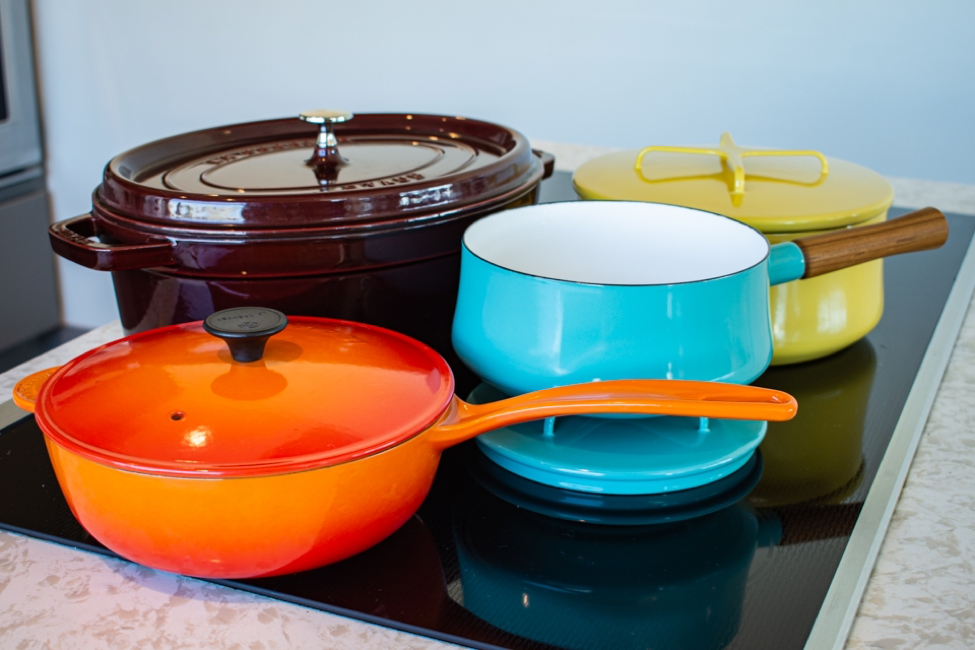
Whether you prioritize durability, heat conductivity, or ease of cleaning, selecting the right cookware material will set you up for success in the kitchen. Sadly, fully grasping this can be confusing especially with the number of options currently available in the market. This is why we’ve included a brief explanation in today’s kitchen tips.
Here’s a quick guide that will help:
Overview of Common Cookware Materials
- Stainless Steel: Known for its durability, stainless steel cookware is resistant to corrosion, rust, and staining. It’s versatile and suitable for a wide range of cooking techniques, including searing, sautéing, and simmering. However, stainless steel may have poor heat conductivity, resulting in uneven cooking if not properly layered with other materials.
- Cast Iron: Cast iron cookware is prized for its excellent heat retention and distribution, making it ideal for slow cooking, searing, and baking. It’s durable, affordable, and naturally nonstick when properly seasoned. However, cast iron requires regular maintenance to prevent rusting and may be heavy and prone to cracking if mishandled.
- Nonstick: Nonstick cookware features a coating that prevents food from sticking, making it easy to clean and ideal for low-fat cooking. It’s suitable for delicate foods like eggs, pancakes, and fish but may not be suitable for high-heat cooking or metal utensils, as the coating can scratch or degrade over time.
- Copper: Copper cookware offers excellent heat conductivity, allowing for precise temperature control and even cooking. It’s prized by professional chefs for its responsiveness to temperature changes and ability to create perfectly caramelized surfaces. However, copper cookware is expensive, reactive with acidic foods, and requires regular polishing to maintain its appearance.
Pros and Cons of Each Material in Relation to Different Cooking Styles
- Stainless Steel: Pros include durability, versatility, and compatibility with induction cooktops. However, cons may include poor heat conductivity and the potential for food to stick if not properly preheated.
- Cast Iron: Pros include excellent heat retention, durability, and versatility. However, cons may include the need for seasoning and regular maintenance, as well as its weight and potential for rusting if not properly cared for.
- Nonstick: Pros include easy cleanup and suitability for low-fat cooking. However, cons may include limitations on high-heat cooking and concerns about the durability and safety of the nonstick coating.
- Copper: Pros include superior heat conductivity and responsiveness, as well as aesthetic appeal. However, cons may include high cost, reactivity with acidic foods, and the need for regular polishing to prevent tarnishing.
Matching Cookware Materials to Cooking Techniques and Preferences
- Consider your preferred cooking techniques and recipes when selecting cookware materials. For example, if you frequently sear meats or sauté vegetables, you may prioritize cookware with excellent heat retention and distribution, such as cast iron or stainless steel clad with aluminum or copper.
- Think about the types of foods you enjoy cooking and whether they require precise temperature control or gentle heat. For delicate dishes like omelets or fish, nonstick cookware may be preferred, while copper cookware may excel at caramelizing sugars or achieving crispy textures.
3. Heat Conduction and Distribution
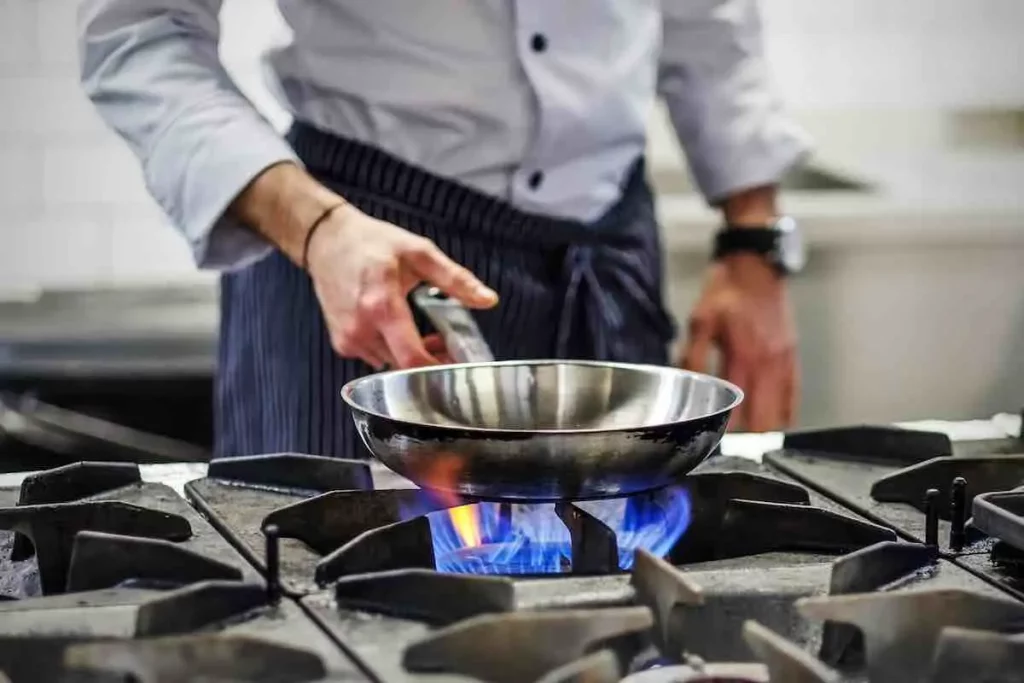
As far as kitchen tips go, understanding how your cookware manages heat ranks at the very top. It’s important that you know how heat is conducted and distributed in different cookware materials. This knowledge will help you achieve better consistency in your cooking. This is because you will know what cookware will offer optimal heat conductivity for a cooking technique or recipe.
Let’s look at a simple guide that will help you make the right selection.
Understanding the Importance of Even Heat Distribution
Before we begin to look at how to make this selection, let’s first explain the importance of having an even heat distribution:
- Even heat distribution is crucial for achieving consistent cooking results and avoiding hot spots that can lead to unevenly cooked food.
- Proper heat distribution ensures that food cooks uniformly, preventing overcooked or undercooked areas and ensuring optimal flavor and texture.
A Look at How Different Materials Conduct and Distribute Heat
- Materials like copper and aluminum are known for their excellent heat conductivity, allowing heat to spread quickly and evenly across the cooking surface.
- Stainless steel, while durable and versatile, has lower heat conductivity and may require additional layers of more conductive materials, such as aluminum or copper, to improve heat distribution.
- Cast iron has high heat retention but relatively slow heat conductivity, meaning it heats up slowly but retains heat well once hot, making it ideal for slow cooking and searing.
Selecting Cookware with Optimal Heat Conductivity for Your Cooking Style
- Consider your preferred cooking techniques and recipes when choosing cookware based on heat conductivity.
- If you frequently sear meats, sauté vegetables, or stir-fry dishes, prioritize cookware with excellent heat conductivity to ensure quick and even cooking.
- For delicate dishes that require precise temperature control, such as sauces or custards, opt for cookware with superior heat distribution to prevent scorching or burning.
- Balance heat conductivity with other factors like durability, maintenance, and compatibility with your cooktop to choose cookware that best suits your cooking style and needs.
4. Durability and Maintenance
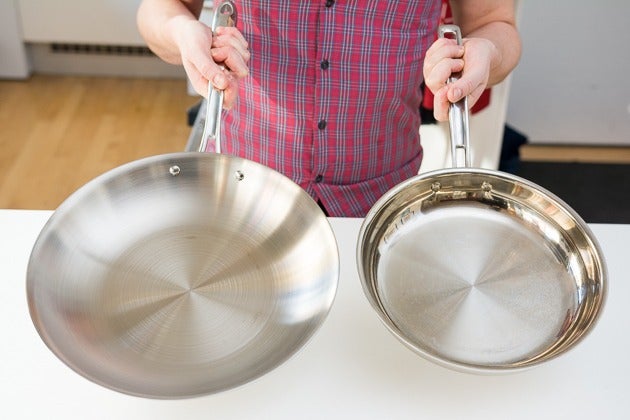
One important selection consideration when choosing cookware is its maintenance requirement and of course its durability. You cooking frequency and recipie will play an important role here.
Let’s consider this for a moment, starting with the importance of your cookware’s durability
Importance of Durability
- Durability is a key consideration when selecting cookware, as it impacts the longevity and performance of your kitchen tools.
- Durable cookware can withstand frequent use, high temperatures, and regular cleaning without warping, scratching, or deteriorating over time.
- Investing in durable cookware ensures that your kitchen tools will last for years to come, saving you money in the long run and providing reliable performance in the kitchen.
Maintenance Requirements for Different Types of Cookware
- Different types of cookware have varying maintenance requirements based on their materials and construction.
- Stainless steel cookware is highly durable and resistant to corrosion, making it easy to clean and maintain. Simply wash with soap and water, and occasionally polish to maintain its shine.
- Cast iron cookware requires seasoning to create a natural nonstick surface and prevent rusting. Regular seasoning and proper drying after use are essential for maintaining cast iron cookware’s durability and performance.
- Nonstick cookware should be used with care to avoid scratching or damaging the nonstick coating. Avoid using metal utensils and abrasive cleaners, and hand wash gently to prolong the life of the nonstick surface.
- Copper cookware requires regular polishing to prevent tarnishing and maintain its appearance. Additionally, copper cookware should be lined with a nonreactive material like stainless steel or tin to prevent acidic foods from reacting with the copper.
Balancing Durability and Maintenance with Cooking Style and Frequency of Use
- Consider your cooking style and frequency of use when evaluating the durability and maintenance requirements of different types of cookware.
- If you cook frequently and prefer low-maintenance tools, opt for durable cookware materials like stainless steel or enameled cast iron that require minimal upkeep.
- If you enjoy the benefits of cast iron or copper cookware but are willing to invest time in maintenance, these materials can provide excellent durability and performance.
- Be realistic about your willingness to perform regular maintenance tasks like seasoning, polishing, and handwashing, and choose cookware that aligns with your lifestyle and preferences.
5. Size and Shape Considerations
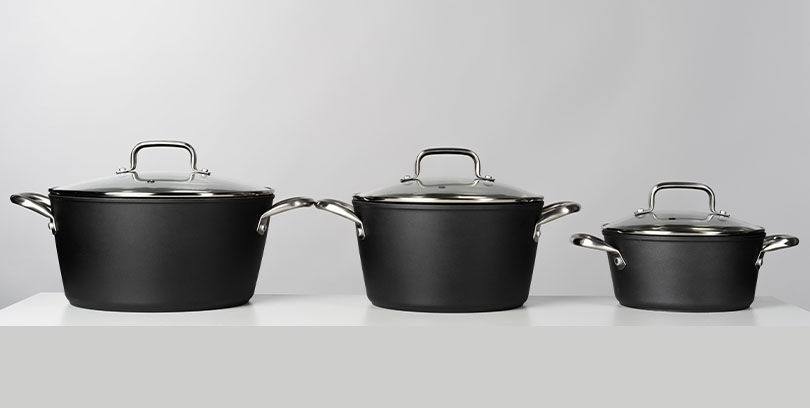
This should be an obvious consideration factor, especially the size you go for. We will be exploring this factor in this section, taking a look at from different angles so you can get a holistic view.
Assess Your Cooking Needs
- Begin by evaluating your typical batch sizes and the number of people you usually cook for. Consider whether you often cook for a small family, entertain guests frequently, or prepare meals in bulk for meal prep.
- Take into account the size of your kitchen and available storage space when selecting cookware. Ensure that the cookware you choose fits comfortably in your cabinets and on your stovetop or cooktop.
Choose the Right Size
- Select cookware sizes that match the portion sizes you typically prepare. For example, if you frequently cook for a family of four, opt for larger pots and pans that can accommodate larger batch sizes.
- Consider the depth and capacity of cookware when choosing sizes. Deep pots are ideal for soups, stews, and boiling pasta, while shallow pans are suitable for sautéing, frying, and searing.
Considering Versatility
- Choose cookware sizes and shapes that offer versatility for various cooking techniques and recipes. Look for pots and pans that can be used interchangeably for different dishes to minimize the number of pieces you need.
- Consider investing in multi-purpose cookware, such as a Dutch oven or a skillet with a lid, that can perform multiple functions like braising, roasting, and baking.
Consider Ergonomic Factors
- Pay attention to the handles and lids of cookware to ensure they are comfortable to hold and easy to use. Opt for cookware with ergonomic handles that provide a secure grip and stay cool to the touch during cooking.
- Choose lids that fit securely on pots and pans to lock in heat and moisture while cooking. Look for lids with heat-resistant handles or knobs that are easy to grasp and lift.
Consider Your Storage Space
- Strike a balance between cookware size and available storage space in your kitchen. Avoid overcrowding your cabinets with oversized cookware that takes up too much room and makes it difficult to access other items.
- Consider nesting cookware sets or stackable options to maximize storage efficiency and minimize clutter in your kitchen cabinets.
6. Compatibility with Cooktops and Ovens
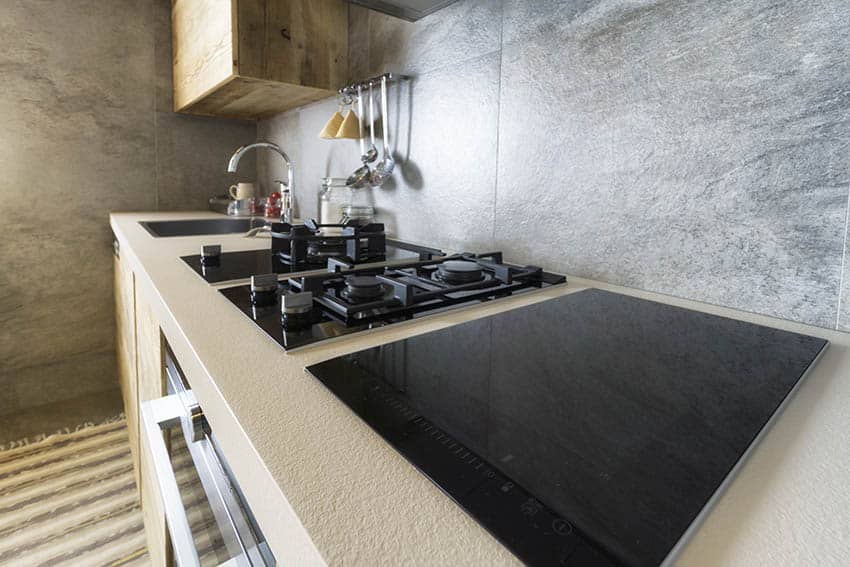
Before you begin to choose your cookware, you must first be aware that the type of cooktop you own or will be using is an important consideration factor. This is important because all cookware do not work well with all cooktops. You must therefore be sure that the choice you are making is compatible with your cooktop.
Let’s break this down some more..
The Basics of Cookware Compatibility
- Different types of cookware are compatible with specific types of cooktops and ovens based on their materials and construction.
- Gas cooktops require cookware with flat bottoms and stable bases to ensure even heat distribution and prevent tipping.
- Electric cooktops, including coil and smooth-top models, are compatible with most types of cookware, but may require specific materials like stainless steel or cast iron for optimal performance.
- Induction cooktops require cookware with magnetic properties, such as stainless steel or cast iron, to generate heat. Non-magnetic materials like aluminum or copper are not compatible with induction cooktops unless they have a magnetic base.
Choosing Oven-Safe Cookware
- Not all cookware is oven-safe, so it’s essential to check the manufacturer’s specifications before using cookware in the oven.
- Oven-safe cookware allows you to transition dishes from stovetop to oven without transferring them to different containers, saving time and minimizing cleanup.
- Look for cookware with oven-safe temperature ratings that match the temperatures you typically use for roasting, baking, or broiling.
Consider Versatility for Stovetop-to-Oven Cooking
- If you frequently use both stovetop and oven cooking techniques, prioritize cookware that offers versatility for transitioning between the two.
- Choose cookware with oven-safe handles and lids that can withstand high temperatures without warping or melting.
- Look for pieces like skillets, Dutch ovens, and roasting pans that are suitable for both stovetop and oven cooking, allowing you to sear, sauté, roast, and bake with ease.
Consider Cookware Handles and Lids
- Pay attention to the materials and construction of cookware handles and lids to ensure they are oven-safe.
- Opt for cookware with heat-resistant handles made from materials like silicone, stainless steel, or phenolic resin that remain cool to the touch during stovetop and oven use.
- Choose lids with oven-safe knobs or handles that can withstand high temperatures without melting or becoming damaged.
Check for Manufacturer Guidelines
- Always refer to the manufacturer’s guidelines and care instructions for specific recommendations regarding cookware compatibility with cooktops and ovens.
- Some cookware may have limitations or restrictions for use on certain cooktops or in particular oven settings, so it’s essential to follow the manufacturer’s recommendations to prevent damage to your cookware or appliances.
7. Budget Considerations

As with most things, budget considerations are essential when choosing cookware that meets your cooking needs and financial constraints. Whether you’re starting from scratch or upgrading your existing collection, thoughtful budgeting will ensure that you get the most for your buck.
Here’s how you can go about proper budgeting:
Setting a Realistic Budget
- Begin by establishing a budget for your cookware purchases based on your financial situation and cooking needs.
- Consider how often you cook, the variety of dishes you prepare, and the longevity you expect from your cookware to determine a reasonable budget.
Identify Essential Pieces
- Prioritize essential cookware pieces that you use regularly and consider them as the foundation of your cookware collection.
- Focus on versatile pieces that can perform multiple functions and accommodate a variety of cooking techniques to maximize the value of your investment.
Evaluate Cost-Effective Options
- Research different cookware brands and materials to identify cost-effective options that meet your budget constraints without compromising quality or performance.
- Consider purchasing cookware sets or multi-piece bundles that offer savings compared to buying individual pieces separately.
- Look for sales, discounts, and promotions from reputable retailers to get the best value for your money.
Balancing Quality and Affordability
- Strike a balance between quality and affordability when choosing cookware within your budget.
- While it’s tempting to opt for the cheapest option available, investing in higher-quality cookware made from durable materials can save you money in the long run by lasting longer and performing better.
- Consider the lifetime cost of ownership, including maintenance and replacement costs, when comparing different cookware options to ensure that you get the best value for your budget.
Considering Long-Term Investment
- Think of cookware purchases as a long-term investment in your kitchen and culinary skills.
- While high-quality cookware may have a higher upfront cost, it can pay off over time by providing reliable performance, durability, and versatility.
- Consider purchasing one or two high-quality pieces at a time and gradually building your cookware collection over time to spread out the cost and ensure that each piece meets your standards and preferences.
8. Reviews and Recommendations

While this final section may not exactly be listed among kitchen tips, it’s nontheless quite essential. Reviews and recommendations are invaluable resources for selecting any product, including cookware that meets your needs. Reading reviews and recommendations about different products from existing users allows you a peek into the possible benefits and disadvantages that each product offers even without owning it yourself. This certainly increases your chances of making the right choice.
Here’s how to go about it..
Research Cookware Brands and Products
- Begin by researching cookware brands and products to familiarize yourself with the options available on the market.
- Explore online resources, including consumer review websites, cooking forums, and social media platforms, to gather insights and feedback from other users.
- Look for reputable sources that provide unbiased reviews and comprehensive information about cookware performance, durability, and value.
- Seeking Advice from Trusted Sources:
- Reach out to friends, family members, or colleagues who are experienced cooks or culinary enthusiasts for recommendations and advice.
- Consider consulting professional chefs, cooking instructors, or kitchen experts for expert opinions and insights into the best cookware brands and products.
- Attend cooking classes, workshops, or demonstrations where you can learn firsthand about different cookware options and receive personalized recommendations based on your cooking preferences.
Make Use of Online Resources and Customer Reviews
- Take advantage of online resources such as retailer websites, cooking blogs, and online marketplaces to explore cookware options and read customer reviews.
- Pay attention to both positive and negative reviews to gain a balanced perspective on the strengths and weaknesses of different cookware brands and products.
- Look for reviews that provide detailed information about cookware performance, durability, ease of use, and value for money to help you make informed decisions.
Consider Factors Beyond Price
- While price is an important factor to consider, don’t rely solely on price when evaluating cookware options.
- Consider factors such as material quality, construction, design, and features to determine the overall value and suitability of cookware for your needs.
- Keep in mind that higher-priced cookware may offer better performance, durability, and versatility, but there are also budget-friendly options that provide excellent value for money.
Make Informed Decisions
- Use the information gathered from reviews and recommendations to narrow down your options and make informed decisions about which cookware brands and products to purchase.
- Consider creating a shortlist of top-rated cookware options and comparing them based on key criteria such as material, construction, price, and customer feedback.
- Take your time to weigh the pros and cons of each option and choose cookware that aligns with your cooking style, preferences, and budget.
Conclusion of Kitchen Tips
In conclusion, thorough research, thoughtful consideration of your cooking needs, and balancing factors like durability, compatibility, and budget are key to selecting the right cookware. Whether you’re a beginner cook or a seasoned chef, the kitchen tips we’ve shared in this article will help you choose the right cookware that will set the stage for delicious meals and enjoyable cooking adventures.













